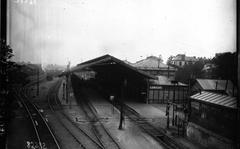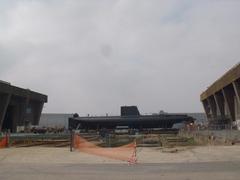Visiting the Prow of the Marsouin in Lorient, France – Tickets, Hours, and Essential Tips
Date: 14/06/2025
Introduction
Nestled along the vibrant coast of Southern Brittany, the Prow of the Marsouin (Étrave du Marsouin) is a compelling maritime monument that encapsulates Lorient’s rich naval heritage and innovative spirit. Located in the revitalized La Base district, this striking structure is more than just an architectural statement—it stands as a symbol of resilience, commemoration, and the enduring relationship between Lorient and the sea. This guide will walk you through the historical significance of the Prow, its unique architectural features, practical visitor information, and expert tips for exploring Lorient’s maritime treasures.
For the latest updates on visiting hours, guided tours, and local events, consult official resources and the Audiala app for personalized recommendations (visit-lorient-brittany.com).
Table of Contents
- Lorient’s Maritime Origins and Evolution
- The Prow of the Marsouin: Symbolism and Context
- Architectural and Cultural Significance
- Visitor Information: Hours, Tickets & Accessibility
- Exploring La Base and Nearby Attractions
- Practical Tips and FAQs
- Conclusion and Resources
Lorient’s Maritime Origins and Evolution
Lorient’s maritime roots trace back to the 17th century with the establishment of the French East India Company, which transformed it into a strategic port for trade with Asia and beyond (visit-lorient-brittany.com). The city’s name itself—meaning “the Orient”—reflects this global connection. Over time, Lorient evolved into a significant naval base, particularly during WWII when the Keroman Submarine Base was constructed, surviving heavy Allied bombing (placesandthingstodo.com).
Today, Lorient is a dynamic city with five thriving ports: military, commercial, fishing, sailing, and passenger. Its vibrant maritime culture is preserved through museums, festivals, and educational initiatives (about2cruise.co.uk).
The Prow of the Marsouin: Symbolism and Context
The Prow of the Marsouin commemorates the French Narval-class submarine Marsouin, built at Lorient’s Keroman Submarine Base in the 1950s (tripadvisor.com). Preserving the submarine’s prow as a monument, Lorient honors its naval engineering legacy and the sailors who served beneath the waves. The monument stands as a testament to the city’s technological prowess, resilience, and collective memory, deeply integrated into local commemorations and educational programs (visit-lorient-brittany.com).
Architectural and Cultural Significance
Modernist Design and Materiality
The Prow’s angular, ship-like form exemplifies Lorient’s post-war architectural rebirth, using stone, concrete, and steel to symbolize both resilience and modernity (Jidipi Architectures). Its orientation toward the water is a constant reminder of the city’s maritime destiny.
Nearby, the Lorient Bretagne-Sud Railway Station and the Community House (Maison de la Communauté) echo this design philosophy, blending innovative materials with nautical references (archdaily.com).
Cultural Role and Events
The Prow serves as a focal point for major events, including the renowned Festival Interceltique de Lorient—Europe’s largest Celtic festival, attracting hundreds of thousands of visitors each August (france-voyage.com; brittanytourism.com). The monument is central to public art projects, commemorative ceremonies, and maritime-themed workshops that animate Lorient’s cultural calendar.
Sustainability and Urban Regeneration
The Prow’s design incorporates sustainable features such as “virtual hanging gardens” that maximize natural light and energy efficiency (archdaily.com). Its integration within La Base exemplifies Lorient’s commitment to transforming historical sites into vibrant community spaces.
Visitor Information: Hours, Tickets & Accessibility
Opening Hours
- Prow of the Marsouin: Outdoor monument accessible year-round, typically from 9:00 AM to 6:00 PM, with extended hours in summer.
- Nearby Museums (e.g., Cité de la Voile Éric Tabarly): Open daily, generally 10:00 AM–6:00 PM. Always confirm hours on the official tourism website as they may vary seasonally.
Tickets
- Prow of the Marsouin: Free to access.
- Museums (Cité de la Voile Éric Tabarly, Keroman Submarine Base): Ticketed entry. Adult tickets range from €7 to €12; discounts for children, students, and seniors.
Advance booking is recommended for guided tours, especially during the summer or major festivals.
Accessibility
- Mobility: The site is wheelchair accessible, with ramps and elevators to the terrace. Assistance is available upon request (Tourisme Bretagne Handi-Tourisme).
- Facilities: Accessible toilets, seating, and clear bilingual signage are provided. Nearby, cafés and rest areas are available for visitors.
Exploring La Base and Nearby Attractions
La Base is Lorient’s redeveloped submarine base district, now a lively hub for maritime culture, leisure, and history. Enhance your visit by exploring:
- Cité de la Voile Éric Tabarly: Interactive sailing museum with hands-on exhibits, simulators, and boat tours (Triplyzer).
- Sous-marin Flore-S645: Museum inside a real submarine, offering an immersive naval experience (Triplyzer).
- Keroman Fishing Port: One of France’s largest fishing harbors, with markets and authentic seafood restaurants (ChooseWhere).
- Marina Promenade: Ideal for waterfront strolls, yacht-watching, and boat rentals.
- Playgrounds and Green Spaces: Family-friendly recreation areas such as Aire De Jeux La Base (Real Journey Travels).
Practical Tips and FAQs
Getting There
- By Car: Ample parking near La Base; accessible spaces available.
- Public Transport: Bus lines connect Lorient center to La Base; stops are within walking distance.
- Bicycle: Dedicated bike lanes and racks on-site.
Best Time to Visit
- May–September: Pleasant weather (13°C–19°C), lively atmosphere, and extended opening hours (Weather25).
- Events: The Festival Interceltique in August offers a unique cultural experience.
What to Bring
- Comfortable walking shoes and weather-appropriate clothing.
- Camera for panoramic harbor views.
- Reusable water bottle and sun protection in summer.
Local Etiquette
- Greet staff and locals with “Bonjour.”
- Tipping is appreciated but not obligatory.
- Many restaurants close for lunch between 12:00–14:00; plan accordingly (Lonely Planet France Etiquette).
Frequently Asked Questions
Q: What are the Prow of the Marsouin visiting hours?
A: The outdoor monument is accessible daily, generally from 9:00 AM to 6:00 PM (may vary by season).
Q: Is there an entrance fee?
A: No, visiting the Prow is free. Museums and guided tours require a ticket.
Q: Is the site accessible for visitors with reduced mobility?
A: Yes, with ramps, elevators, and accessible facilities.
Q: Are guided tours available?
A: Yes, in both English and French. Book in advance via official tourism channels.
Q: Can I bring children?
A: Absolutely. The site and nearby playgrounds are family-friendly.
Conclusion and Resources
The Prow of the Marsouin is more than an architectural landmark—it’s a gateway to understanding Lorient’s remarkable maritime history and its ongoing spirit of innovation. Whether you’re a history enthusiast, architecture lover, or cultural traveler, this site offers a rewarding and accessible experience for all. Enhance your visit by exploring La Base’s museums, enjoying local Breton cuisine, and timing your trip to coincide with Lorient’s vibrant festivals.
For up-to-date visitor information, interactive maps, and personalized recommendations, download the Audiala app and consult the official Lorient tourism websites.
Internal Links
External Sources
- Visit Lorient Brittany – What to See and Do
- France-Voyage Lorient Tourism
- Keroman Submarine Base Reviews (TripAdvisor)
- About2Cruise Lorient Cruise Port Guide
- Jidipi Architectures: Lorient Bretagne-Sud Railway Station
- Community House of Lorient Architecture (ArchDaily)
- Brittany Tourism – Festival Interceltique de Lorient
- ChooseWhere Lorient Visitor Guide
- Triplyzer – Things to Do in Lorient
- Real Journey Travels – Aire De Jeux La Base
- Tourisme Bretagne Handi-Tourisme
- Weather25 Lorient Monthly Weather
- Lonely Planet France Etiquette
For more travel inspiration, event updates, and expert advice for your Brittany adventure, follow us on social media and explore our blog.

